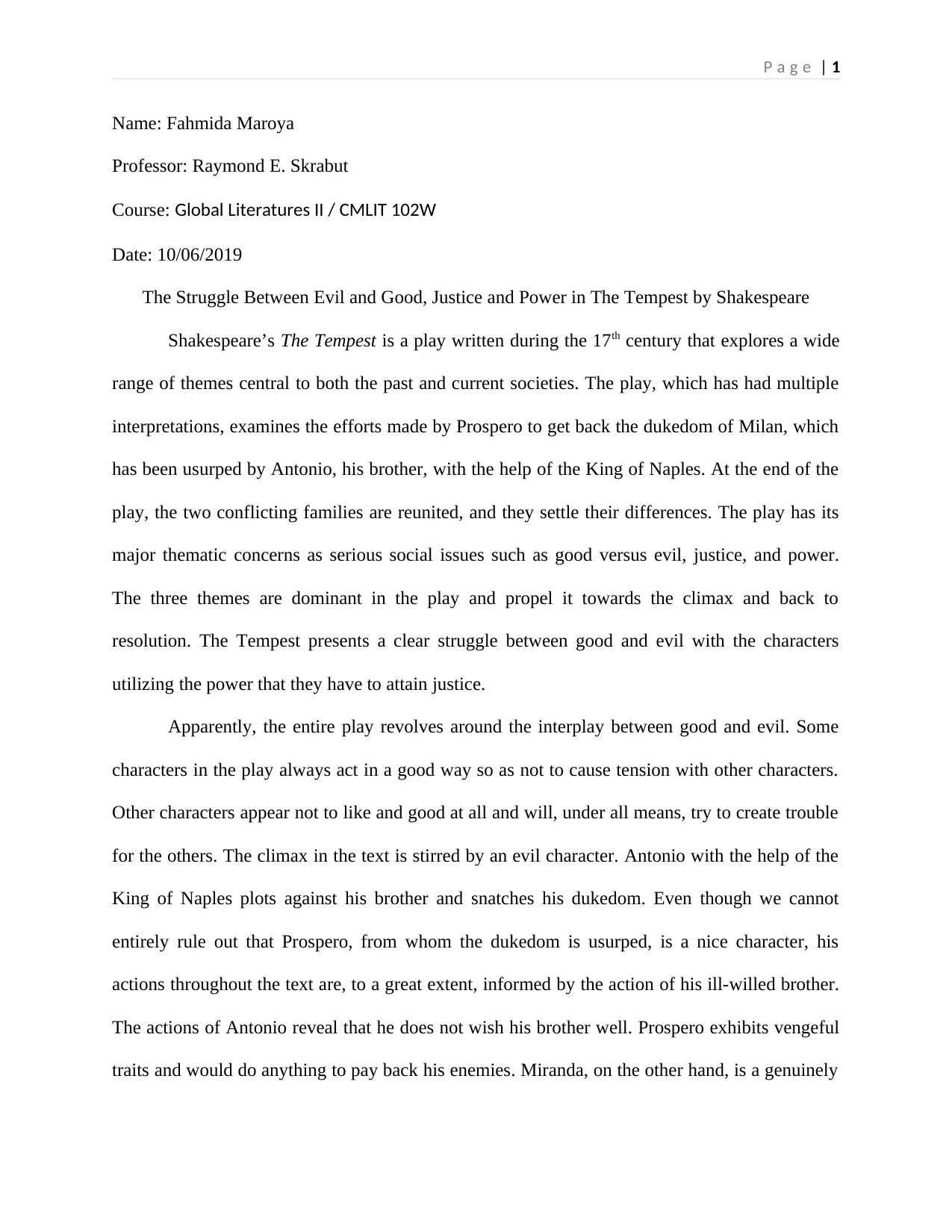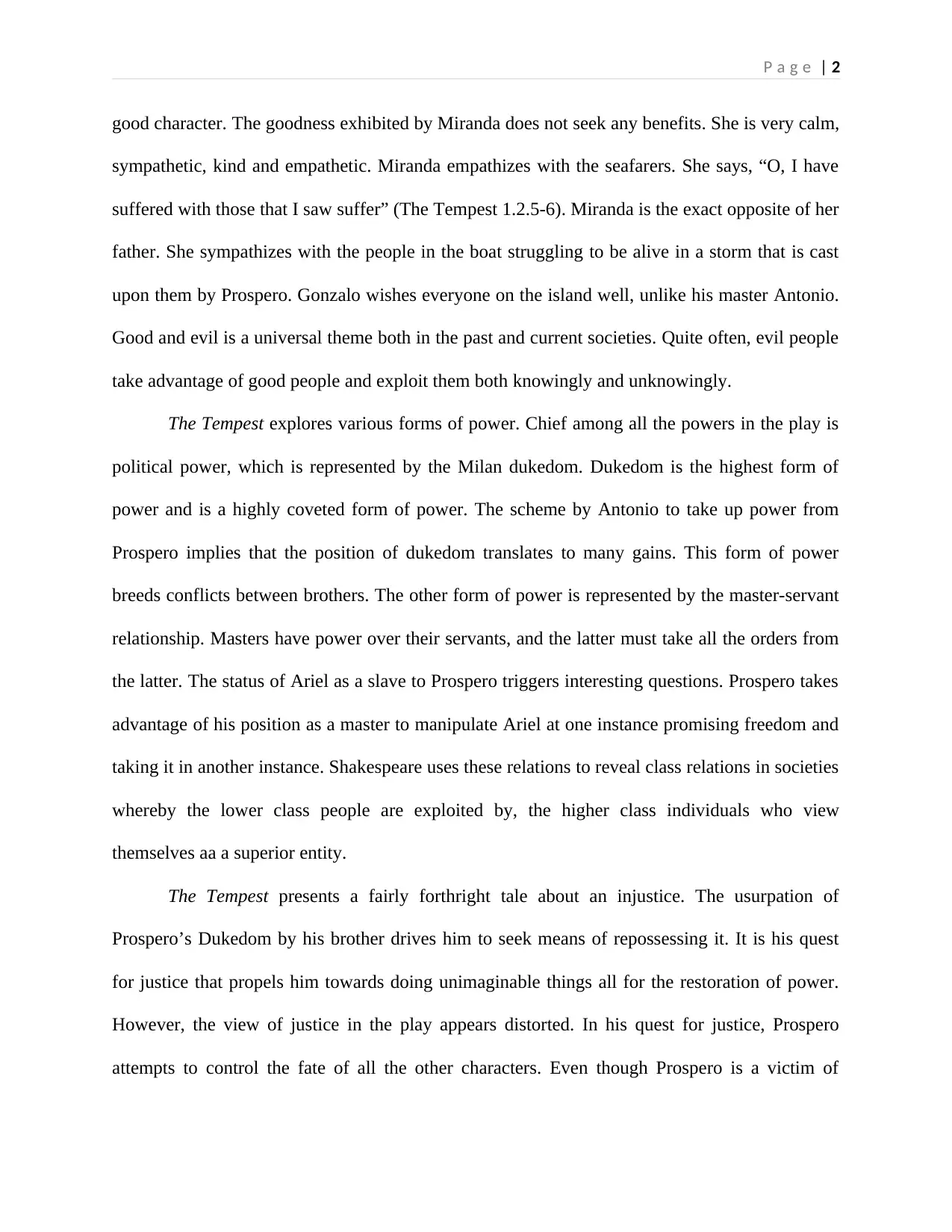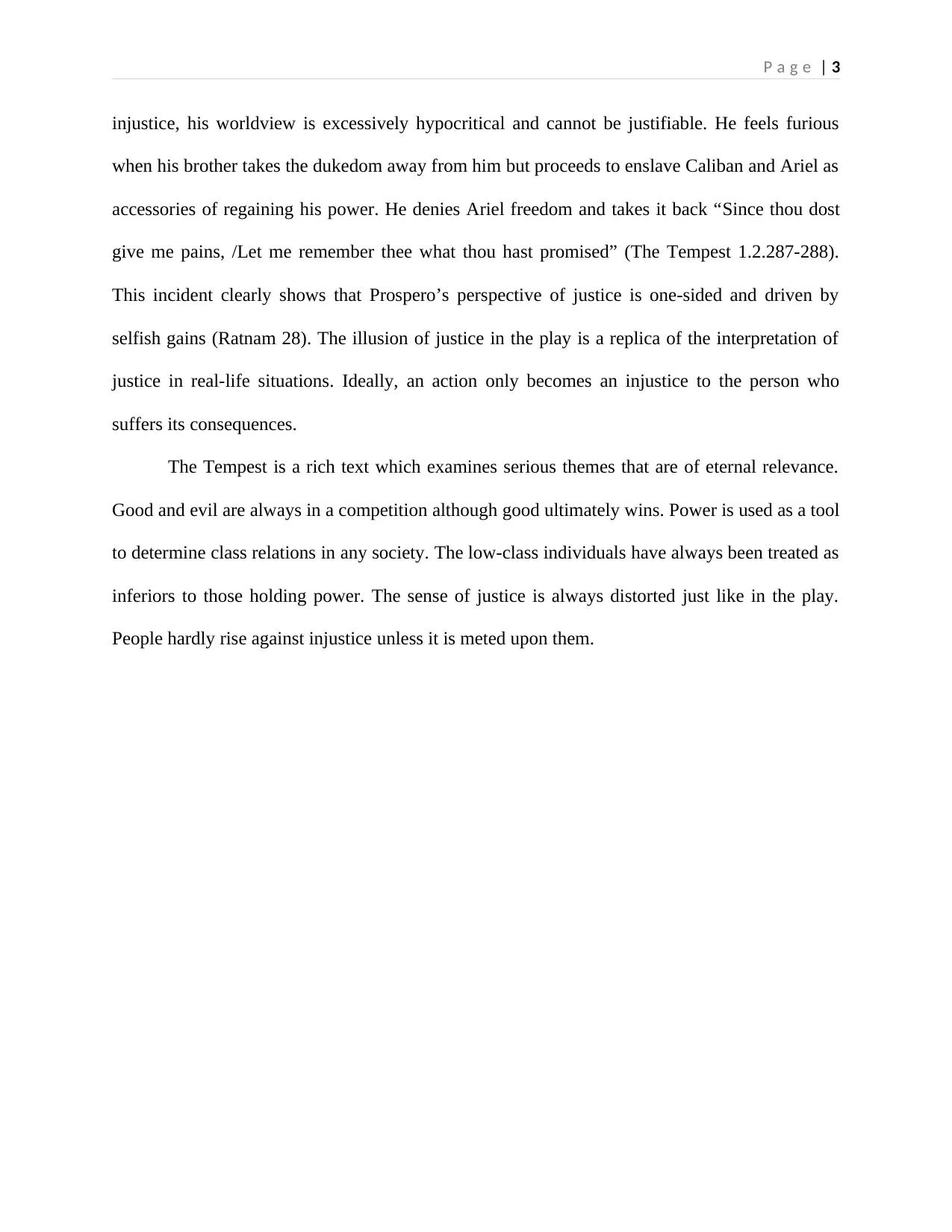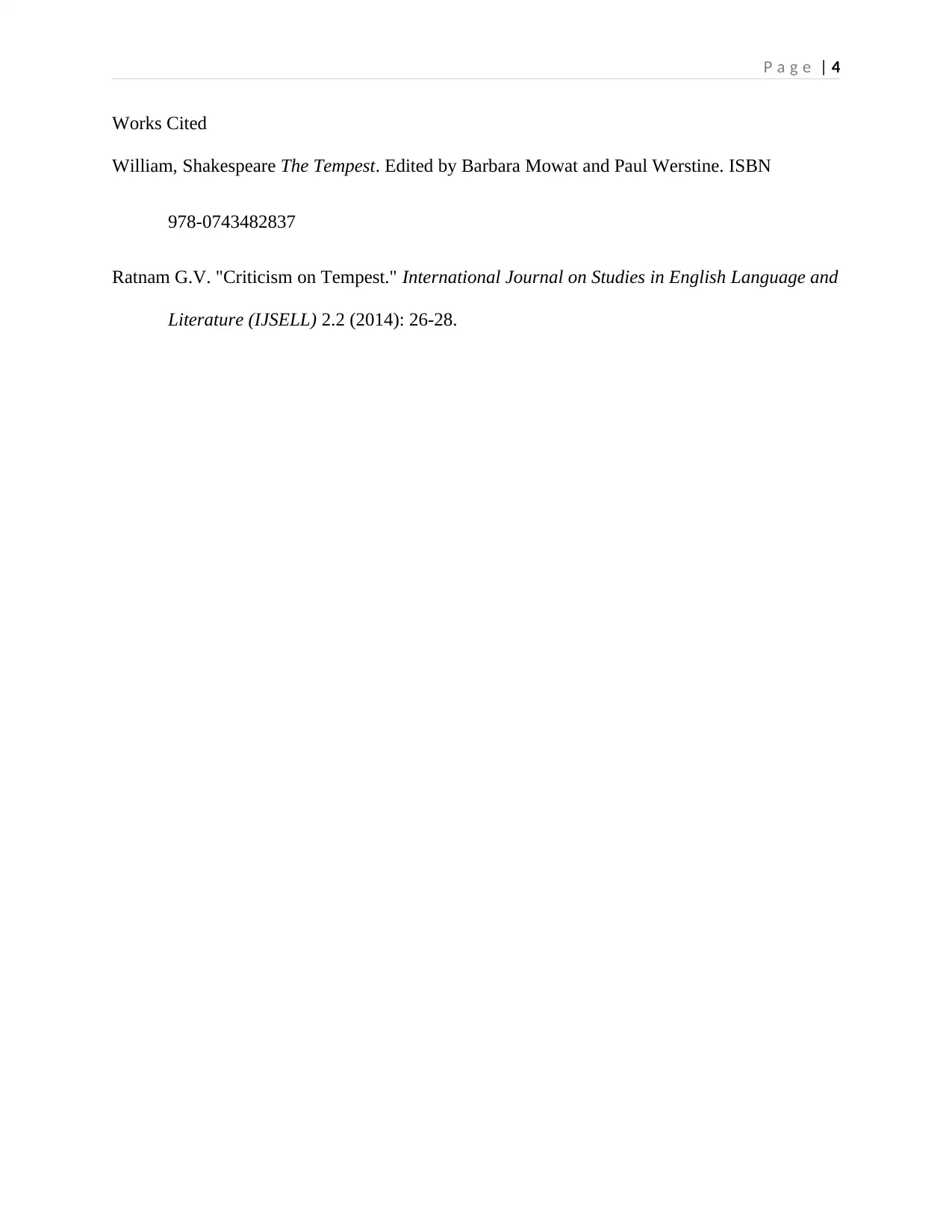Analysis of Themes in Shakespeare's The Tempest (CMLIT 102W)
VerifiedAdded on 2022/09/28
|4
|1012
|23
Essay
AI Summary
This essay, written for a Global Literatures II course, analyzes William Shakespeare's *The Tempest*, focusing on the interplay of good and evil, the concept of justice, and the dynamics of power within the play. The author examines how characters such as Prospero, Antonio, and Miranda embody these themes, highlighting the conflicts and resolutions that drive the narrative. The essay explores political power, master-servant relationships, and the distorted nature of justice, supporting its arguments with textual evidence and critical interpretations. Ultimately, the analysis reveals the enduring relevance of these themes in both historical and contemporary contexts, demonstrating how Shakespeare's work continues to reflect and critique societal structures and human nature. The essay also references the work of Ratnam, in his criticism on *The Tempest*.

P a g e | 1
Name: Fahmida Maroya
Professor: Raymond E. Skrabut
Course: Global Literatures II / CMLIT 102W
Date: 10/06/2019
The Struggle Between Evil and Good, Justice and Power in The Tempest by Shakespeare
Shakespeare’s The Tempest is a play written during the 17th century that explores a wide
range of themes central to both the past and current societies. The play, which has had multiple
interpretations, examines the efforts made by Prospero to get back the dukedom of Milan, which
has been usurped by Antonio, his brother, with the help of the King of Naples. At the end of the
play, the two conflicting families are reunited, and they settle their differences. The play has its
major thematic concerns as serious social issues such as good versus evil, justice, and power.
The three themes are dominant in the play and propel it towards the climax and back to
resolution. The Tempest presents a clear struggle between good and evil with the characters
utilizing the power that they have to attain justice.
Apparently, the entire play revolves around the interplay between good and evil. Some
characters in the play always act in a good way so as not to cause tension with other characters.
Other characters appear not to like and good at all and will, under all means, try to create trouble
for the others. The climax in the text is stirred by an evil character. Antonio with the help of the
King of Naples plots against his brother and snatches his dukedom. Even though we cannot
entirely rule out that Prospero, from whom the dukedom is usurped, is a nice character, his
actions throughout the text are, to a great extent, informed by the action of his ill-willed brother.
The actions of Antonio reveal that he does not wish his brother well. Prospero exhibits vengeful
traits and would do anything to pay back his enemies. Miranda, on the other hand, is a genuinely
Name: Fahmida Maroya
Professor: Raymond E. Skrabut
Course: Global Literatures II / CMLIT 102W
Date: 10/06/2019
The Struggle Between Evil and Good, Justice and Power in The Tempest by Shakespeare
Shakespeare’s The Tempest is a play written during the 17th century that explores a wide
range of themes central to both the past and current societies. The play, which has had multiple
interpretations, examines the efforts made by Prospero to get back the dukedom of Milan, which
has been usurped by Antonio, his brother, with the help of the King of Naples. At the end of the
play, the two conflicting families are reunited, and they settle their differences. The play has its
major thematic concerns as serious social issues such as good versus evil, justice, and power.
The three themes are dominant in the play and propel it towards the climax and back to
resolution. The Tempest presents a clear struggle between good and evil with the characters
utilizing the power that they have to attain justice.
Apparently, the entire play revolves around the interplay between good and evil. Some
characters in the play always act in a good way so as not to cause tension with other characters.
Other characters appear not to like and good at all and will, under all means, try to create trouble
for the others. The climax in the text is stirred by an evil character. Antonio with the help of the
King of Naples plots against his brother and snatches his dukedom. Even though we cannot
entirely rule out that Prospero, from whom the dukedom is usurped, is a nice character, his
actions throughout the text are, to a great extent, informed by the action of his ill-willed brother.
The actions of Antonio reveal that he does not wish his brother well. Prospero exhibits vengeful
traits and would do anything to pay back his enemies. Miranda, on the other hand, is a genuinely
Paraphrase This Document
Need a fresh take? Get an instant paraphrase of this document with our AI Paraphraser

P a g e | 2
good character. The goodness exhibited by Miranda does not seek any benefits. She is very calm,
sympathetic, kind and empathetic. Miranda empathizes with the seafarers. She says, “O, I have
suffered with those that I saw suffer” (The Tempest 1.2.5-6). Miranda is the exact opposite of her
father. She sympathizes with the people in the boat struggling to be alive in a storm that is cast
upon them by Prospero. Gonzalo wishes everyone on the island well, unlike his master Antonio.
Good and evil is a universal theme both in the past and current societies. Quite often, evil people
take advantage of good people and exploit them both knowingly and unknowingly.
The Tempest explores various forms of power. Chief among all the powers in the play is
political power, which is represented by the Milan dukedom. Dukedom is the highest form of
power and is a highly coveted form of power. The scheme by Antonio to take up power from
Prospero implies that the position of dukedom translates to many gains. This form of power
breeds conflicts between brothers. The other form of power is represented by the master-servant
relationship. Masters have power over their servants, and the latter must take all the orders from
the latter. The status of Ariel as a slave to Prospero triggers interesting questions. Prospero takes
advantage of his position as a master to manipulate Ariel at one instance promising freedom and
taking it in another instance. Shakespeare uses these relations to reveal class relations in societies
whereby the lower class people are exploited by, the higher class individuals who view
themselves aa a superior entity.
The Tempest presents a fairly forthright tale about an injustice. The usurpation of
Prospero’s Dukedom by his brother drives him to seek means of repossessing it. It is his quest
for justice that propels him towards doing unimaginable things all for the restoration of power.
However, the view of justice in the play appears distorted. In his quest for justice, Prospero
attempts to control the fate of all the other characters. Even though Prospero is a victim of
good character. The goodness exhibited by Miranda does not seek any benefits. She is very calm,
sympathetic, kind and empathetic. Miranda empathizes with the seafarers. She says, “O, I have
suffered with those that I saw suffer” (The Tempest 1.2.5-6). Miranda is the exact opposite of her
father. She sympathizes with the people in the boat struggling to be alive in a storm that is cast
upon them by Prospero. Gonzalo wishes everyone on the island well, unlike his master Antonio.
Good and evil is a universal theme both in the past and current societies. Quite often, evil people
take advantage of good people and exploit them both knowingly and unknowingly.
The Tempest explores various forms of power. Chief among all the powers in the play is
political power, which is represented by the Milan dukedom. Dukedom is the highest form of
power and is a highly coveted form of power. The scheme by Antonio to take up power from
Prospero implies that the position of dukedom translates to many gains. This form of power
breeds conflicts between brothers. The other form of power is represented by the master-servant
relationship. Masters have power over their servants, and the latter must take all the orders from
the latter. The status of Ariel as a slave to Prospero triggers interesting questions. Prospero takes
advantage of his position as a master to manipulate Ariel at one instance promising freedom and
taking it in another instance. Shakespeare uses these relations to reveal class relations in societies
whereby the lower class people are exploited by, the higher class individuals who view
themselves aa a superior entity.
The Tempest presents a fairly forthright tale about an injustice. The usurpation of
Prospero’s Dukedom by his brother drives him to seek means of repossessing it. It is his quest
for justice that propels him towards doing unimaginable things all for the restoration of power.
However, the view of justice in the play appears distorted. In his quest for justice, Prospero
attempts to control the fate of all the other characters. Even though Prospero is a victim of

P a g e | 3
injustice, his worldview is excessively hypocritical and cannot be justifiable. He feels furious
when his brother takes the dukedom away from him but proceeds to enslave Caliban and Ariel as
accessories of regaining his power. He denies Ariel freedom and takes it back “Since thou dost
give me pains, /Let me remember thee what thou hast promised” (The Tempest 1.2.287-288).
This incident clearly shows that Prospero’s perspective of justice is one-sided and driven by
selfish gains (Ratnam 28). The illusion of justice in the play is a replica of the interpretation of
justice in real-life situations. Ideally, an action only becomes an injustice to the person who
suffers its consequences.
The Tempest is a rich text which examines serious themes that are of eternal relevance.
Good and evil are always in a competition although good ultimately wins. Power is used as a tool
to determine class relations in any society. The low-class individuals have always been treated as
inferiors to those holding power. The sense of justice is always distorted just like in the play.
People hardly rise against injustice unless it is meted upon them.
injustice, his worldview is excessively hypocritical and cannot be justifiable. He feels furious
when his brother takes the dukedom away from him but proceeds to enslave Caliban and Ariel as
accessories of regaining his power. He denies Ariel freedom and takes it back “Since thou dost
give me pains, /Let me remember thee what thou hast promised” (The Tempest 1.2.287-288).
This incident clearly shows that Prospero’s perspective of justice is one-sided and driven by
selfish gains (Ratnam 28). The illusion of justice in the play is a replica of the interpretation of
justice in real-life situations. Ideally, an action only becomes an injustice to the person who
suffers its consequences.
The Tempest is a rich text which examines serious themes that are of eternal relevance.
Good and evil are always in a competition although good ultimately wins. Power is used as a tool
to determine class relations in any society. The low-class individuals have always been treated as
inferiors to those holding power. The sense of justice is always distorted just like in the play.
People hardly rise against injustice unless it is meted upon them.
⊘ This is a preview!⊘
Do you want full access?
Subscribe today to unlock all pages.

Trusted by 1+ million students worldwide

P a g e | 4
Works Cited
William, Shakespeare The Tempest. Edited by Barbara Mowat and Paul Werstine. ISBN
978-0743482837
Ratnam G.V. "Criticism on Tempest." International Journal on Studies in English Language and
Literature (IJSELL) 2.2 (2014): 26-28.
Works Cited
William, Shakespeare The Tempest. Edited by Barbara Mowat and Paul Werstine. ISBN
978-0743482837
Ratnam G.V. "Criticism on Tempest." International Journal on Studies in English Language and
Literature (IJSELL) 2.2 (2014): 26-28.
1 out of 4
Your All-in-One AI-Powered Toolkit for Academic Success.
+13062052269
info@desklib.com
Available 24*7 on WhatsApp / Email
![[object Object]](/_next/static/media/star-bottom.7253800d.svg)
Unlock your academic potential
Copyright © 2020–2025 A2Z Services. All Rights Reserved. Developed and managed by ZUCOL.

